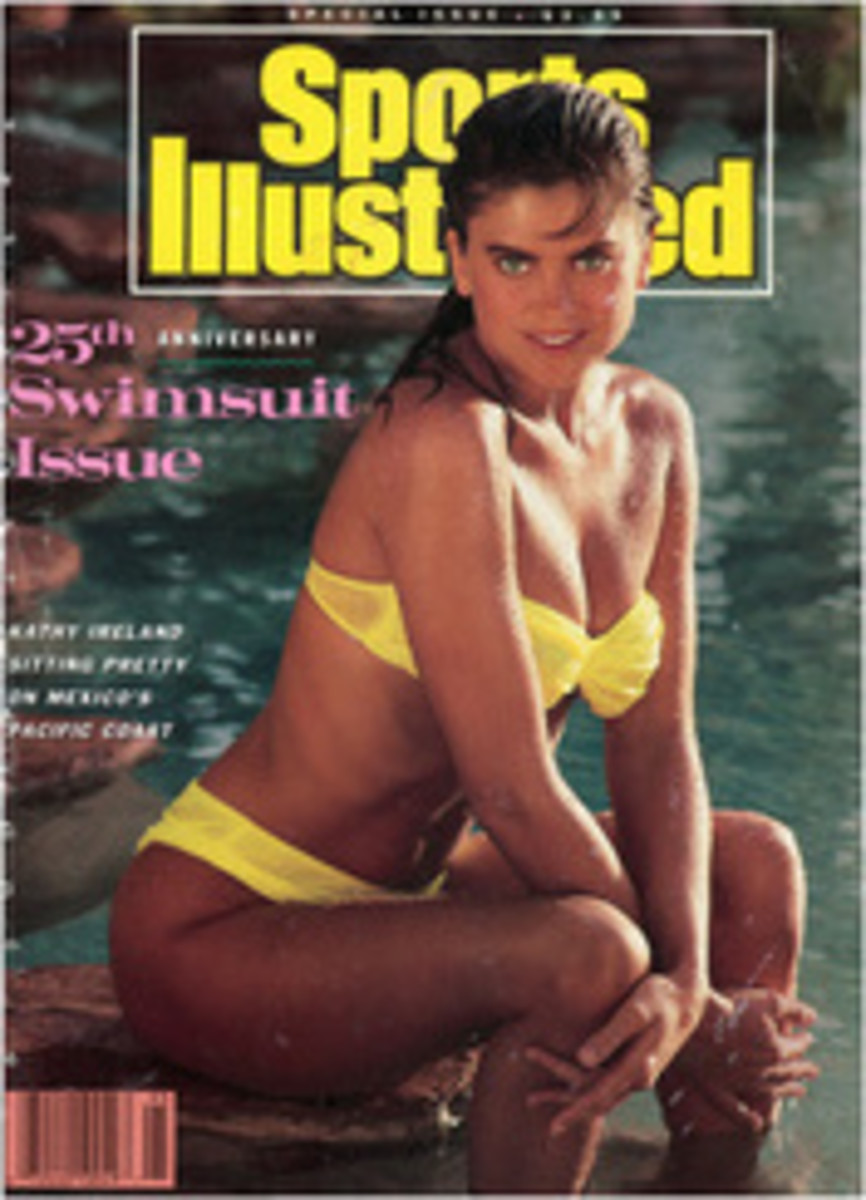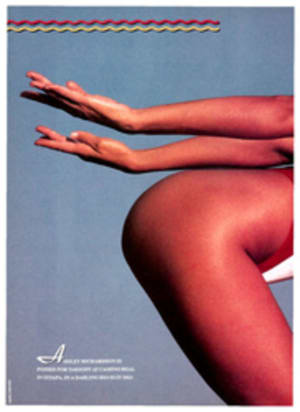
An American In Paris
Jamee Guilbert moves with long, studied strides through the Christian Dior boutique in Paris, touching a sleeve here and there, running her fingers along a hemline, peering at price tags. The clerks have no way of knowing that she's not there to buy, for Guilbert looks very much like the typical well-to-do Dior customer.
"Whatever you put on Jamee, she looked classy," says SI swimsuit editor Jule Campbell. "You couldn't hide it." What Campbell put on her for SI's 1969 swimsuit cover was a lot of rope necklaces and armbands—"This was 1969, after all," says Campbell—as well as a multicolored suit and skirt. Guilbert looks as good today as she did then, when she was Jamee Becker. She has the same flawless skin, the same graceful figure (she was 5'9" and 120 pounds then, and she's 120 pounds now), the same sparkling blue eyes, the same casual elegance.
"Jamee definitely has an upscale look about her," says Bill Weinberg, president of New York City's Wilhelmina Models, the agency that represented her in the States. "Always did, always will."
Guilbert glides over to the lingerie department and touches something lacy. She converses with a clerk in French and informs her English-speaking companion that the garment is called a dèshabillè, which translates roughly as "dressing gown." "Now, really," she says, lowering her voice, "could you imagine schlepping scrambled eggs in that?"
In fact, Guilbert's morning had begun in the kitchen doing just that, as she got her husband, Philippe, off to his job as a clinical psychiatrist and their daughter, 16-year-old Sydney, and son, 11-year-old Justin, off to school. The Guilbert house, which looks small from the outside, is actually a four-story structure with a ground-floor area that has a 20-foot-high ceiling; it formerly served as the studio of a sculptor. The house is located in the 15th Arrondissement, in the southern part of Paris, well off the usual tourist trails.
"It takes a certain amount of maneuvering," says Guilbert, "but you can live well in Paris." And she does. The Guilberts are a close and loving family—and an active one. Jamee has hardly a spare moment to herself. Besides being a full-time homemaker, she is European director for the Los Angeles-based Fashion Institute of Design & Merchandising (FIDM), a school of fashion, merchandising and interior design; a volunteer organizer of social affairs for the Franco-American community in Paris; and a vice-president of the United Service Organizations (USO), the group that looks after visiting American servicemen and women, in Paris. Guilbert, who's 41, doesn't look her age. "But believe me," she says with a laugh, "some mornings I feel it."
Modeling is a family tradition. Guilbert's maternal grandmother, Mildred Bolger, was a well-known model in the 1920s, and Guilbert's mother, Sheila Jackson, was a model and a television personality who hosted The U.S. Steel Hour in the '50s. Jamee, who was raised in Greenwich, Conn., struck out on her own in New York City as an 18-year-old in 1965. She struggled for a few months, modeling bridal gowns by day and working as a waitress by night. Her big break came when she auditioned for a client who needed a model to jump on a trampoline. She had been a gymnast in high school, so she got the job.
Becker's athletic appearance also helped land her the SI cover. "We wanted an outdoorsy, free-spirit type," says Campbell. The cover, which was shot on a beach in Puerto Rico, shows her looking slightly wet, as if she has just jumped off the surfboard being lugged onshore by the man behind her. "Actually I wasn't a bad surfer," Guilbert says. "I could get up gracefully, and I could fall gracefully."
Even after she married Philippe in 1970, moved to Paris and gave birth to Sydney in 1973, she continued to work as a high-fashion model until 1980. "I wasn't a Twiggy or a Jean Shrimpton," she says, "but I was pretty successful. I lasted a long time. I guess what I had was, well...."
"Versatility," says Philippe. "You can say it. Jamee could do anything." That includes preparing a home version of rabbit rèmoulade that Philippe recently had enjoyed in a restaurant. Could there be any more substantive proof that Jamee has earned the dual French and American citizenship that she possesses?
Quiet, intelligent, well-mannered, Philippe is the kind of man you would trust to interpret both your dreams and the entrèe selections on a French menu. He and Jamee met in 1970 in Los Angeles, where she was taking a fling at acting—her modeling agency had sent her to a drama class in L.A., and the highlight of her brief career came when she auditioned for the role of Hot Lips Houlihan in the movie version of M*A*S*H—and Philippe was working at UCLA's Neuropsy-chiatric Institute. He made a less-than-stirring first impression by showing up for their blind date not only with a white Mercedes that he had borrowed from a French actress, but also with the actress, who was behind the wheel.
Still, within weeks Jamee and Philippe were married. Though Philippe is from Armentières ("As in 'Mad'moiselle from...' " he says), they decided to live in Paris, where he could practice psychiatry and Jamee could pursue modeling.
Her work eventually became a strain on the family. Sydney was standing in a train station one day about 12 years ago with Jamee's uncle, Dennis Bolger, when she spotted a poster of her mother, who was in Tunisia on a modeling assignment at the time. The girl burst into tears. Not long after that, Jamee turned down a job that would have kept her away from home for six weeks, and her agency said, in effect, Look, are you a model or a mother?
"Well, that one's easy," Jamee replied, and quit on the spot. She hasn't modeled since.
"I loved the travel and the freedom of modeling, but once I met Philippe, my priorities changed," she says. "The way I looked at it, every time I smiled, we were a little closer to that refrigerator-freezer we needed."
She tends to remember the lighter moments of her modeling career—like the time she tripped over the sword of another model, who was dressed as a West Point cadet, as he escorted her down the runway at a bridal show. Or the time that a security guard refused to let her relieve herself during a fashion show because she happened to be wearing a couple hundred thousand dollars' worth of jewelry. "Finally, I went to the bathroom with the door open and him holding my hand," she says.
The Guilberts are an unpretentious lot. The family car is a rusty, beat-up, 1980 Fiat with a driver's-side door that doesn't open from the outside and an I BRAKE FOR WHALES sticker on the back bumper. Justin, who loves the ocean, supplied the sticker. Jamee attends many fashion shows to collect ideas for FIDM, but she is equally as likely to be struck by examples of what she calls "the peacock world of modeling" as she is by, say, "the vitality of the spring collection."
She's much more serious about her volunteer work in the American community in Paris. She constantly strives to present the best of both French and U.S. culture—"Please don't call me an expatriate," she says—and seems to have taken it upon herself to try to rid the world of the notions that all Parisians are rude and that all Americans are boorish, though she will allow that there are plenty of examples of both. She doesn't just talk a good bicultural game, either. Sydney and Justin attend a bilingual school, and, to ensure that their English stays sharp, Jamee and Philippe speak only English to them.
Jamee became involved in the USO about three years ago through her father, John Becker, an import-export businessman who is a former USO Man of the Year. Her title as vice-president is largely ceremonial, but the workload isn't. For example, in June she helped organize a black-tie benefit for the organization, at the U.S. Embassy in Paris. Pearl Bailey was one of the entertainers.
"Without volunteers like Jamee, the work over here would be very much harder," says Helen Rodgers, the wife of U.S. Ambassador Joe Rodgers. "Jamee has been fabulous. She does everything exactly as it should be done. I didn't see the swim-suit pictures, but I'm sure she's as attractive now as she was then."
Several acquaintances told her the same thing at a recent fashion show she attended to collect notes for FIDM. She was dressed conservatively in a gray suit with blue-rimmed glasses and little makeup. Despite the businesslike garb, one couldn't help but feel that Guilbert could easily step right back into modeling. Indeed, one agency in Paris is currently trying to talk her into doing just that on a part-time basis.
After the show, the nearsighted Guilbert lifted her glasses to scribble a few notes. She looked contemplative. Did she wish she were walking down the runway? She stared directly at the person who asked her the question. "I can't tell you how glad I am that they're up there, and I'm down here," she said.
PHOTO
ERNST HAAS
PHOTO
GREGORY HEISLER
GUILBERT—WIFE, MOTHER, VOLUNTEER WORKER—DOESN'T GET MANY MOMENTS ALONE
PHOTO
GREGORY HEISLER
GUILBERT TALKS SHOP WITH FASHION DESIGNER MICHEL LEGER
THREE ILLUSTRATIONS

